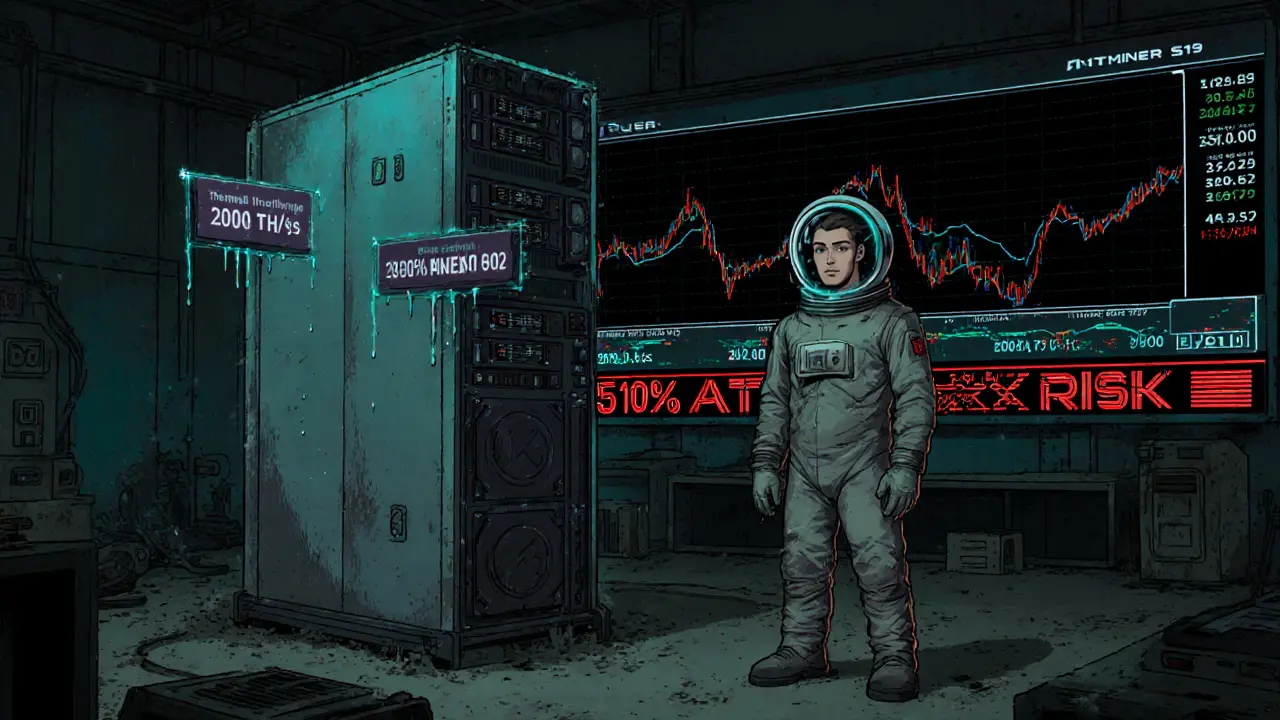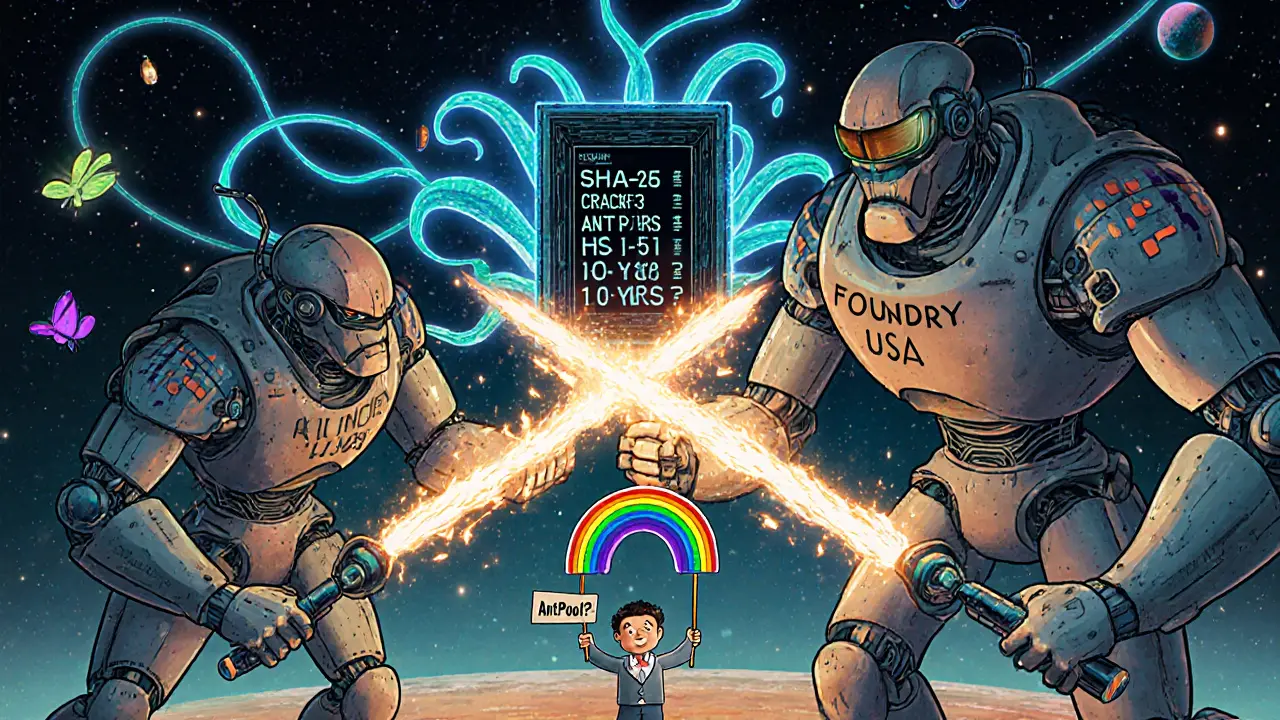How to Calculate Mining Hash Rate for Bitcoin and Other Cryptocurrencies
 Oct, 28 2025
Oct, 28 2025
Bitcoin Hash Rate Calculator
How It Works
This calculator estimates Bitcoin's current hash rate using the official formula: Hash Rate = (Blocks Found × Difficulty) / Time The network adjusts difficulty every 2,016 blocks (about 2 weeks) to maintain 10-minute block times.
When you hear that Bitcoin’s hash rate is at 650 exahashes per second, what does that actually mean? It’s not just a big number-it’s the heartbeat of the entire network. Every second, over 650 quintillion calculations are being run by miners around the world trying to solve a cryptographic puzzle. This isn’t magic. It’s math. And if you’re thinking about mining, you need to understand how it works-not just to guess at profits, but to avoid losing money.
What Is Hash Rate, Really?
Hash rate measures how fast a blockchain network can process cryptographic hash functions. In Bitcoin’s case, miners use powerful machines to guess the correct output of a SHA-256 algorithm. The first one to guess it gets the block reward. The more guesses per second, the higher the hash rate.
It’s not about how smart your miner is-it’s about how many guesses it can make. A single Antminer S21 can do 200 trillion guesses per second (200 TH/s). That sounds insane. But when you add up every miner on the network, you get 650 EH/s-that’s 650 million billion guesses per second.
This number matters because it determines security. The higher the hash rate, the harder it is for someone to take over the network. If a single entity controls more than half the hash rate, they could theoretically reverse transactions or block others. That’s called a 51% attack. Smaller networks like Bitcoin Gold have been hit by this. Bitcoin? It’s never happened. Not because it’s unbreakable-but because the cost to attack it is over $100 billion.
How Hash Rate Is Calculated (The Real Way)
You can’t just count every miner. There are too many, spread across 117 countries. So how do we know the total?
Bitcoin doesn’t measure hash rate directly. It estimates it using a simple formula:
Hash Rate = (Blocks Found × Difficulty) / Time
Every 2,016 blocks (about every two weeks), the network adjusts the difficulty to keep block times at 10 minutes. If blocks are coming too fast, difficulty goes up. Too slow? It goes down.
So if 144 blocks were found in the last 24 hours (which is normal), and the current difficulty is 85 trillion, you plug those numbers in:
Hash Rate ≈ (144 × 85,000,000,000,000) / 86,400 seconds
That gives you roughly 142 EH/s for that day. But since the network uses a 24-hour moving average, it smooths out spikes. That’s why you see numbers like 650 EH/s-it’s not a snapshot. It’s a trend.
Other coins use different methods. Ethereum Classic uses a 100-block average. Monero uses a rolling window based on recent block times. But Bitcoin’s method is the most trusted because it’s tied directly to real block production.
Units of Hash Rate: From H/s to EH/s
Hash rate units grow fast. Here’s what they mean:
- 1 H/s = 1 hash per second (a smartphone could do this)
- 1 KH/s = 1,000 H/s
- 1 MH/s = 1,000,000 H/s
- 1 GH/s = 1 billion H/s (early Bitcoin miners)
- 1 TH/s = 1 trillion H/s (modern ASICs like Antminer S19)
- 1 PH/s = 1 quadrillion H/s
- 1 EH/s = 1 quintillion H/s (Bitcoin’s current network)
When you buy a miner, it says “200 TH/s.” That’s the theoretical maximum under perfect conditions. Real-world performance? Usually 90-95% of that. Why? Heat. Power fluctuations. Dust. Even a 5°C rise in room temperature can drop your hash rate by 2.3%.
One Reddit miner lost $18,500 because he bought 50 Antminer S19j Pros expecting 100 TH/s each. His actual average? 89.7 TH/s. He didn’t account for thermal throttling. That’s the difference between profit and loss.

How Hash Rate Affects Your Profit
Hash rate doesn’t just secure the network-it affects your wallet.
Here’s the connection: Hash Rate → Difficulty → Profitability
When more miners join, hash rate goes up. Difficulty rises. Your miner now has to work harder for the same reward. If your electricity costs $0.10/kWh and the network difficulty jumps 30%, your daily earnings might drop from $12 to $8.50-even if your hardware hasn’t changed.
The formula to estimate daily earnings is:
Hash Value = (Block Reward × 86,400) / (Network Difficulty × 2³²)
Current Bitcoin block reward: 3.125 BTC
Network difficulty (as of Oct 2025): ~85 trillion
2³² = 4,294,967,296
Plug it in:
Hash Value = (3.125 × 86,400) / (85,000,000,000,000 × 4,294,967,296)
That gives you the BTC earned per hash per second. Multiply that by your miner’s hash rate (say, 100 TH/s) to get daily BTC. Then convert to USD and subtract electricity and pool fees.
Most miners use calculators like Hashrate.no or WhatToMine.com. But not all are accurate. MinerStat overestimates earnings by 12-18% during difficulty adjustments. Hashrate.no? 4.7/5 stars from over 1,200 users because it tracks real-time difficulty changes.
Why Some Miners Fail (And How to Avoid It)
Most new miners lose money in the first 90 days. Here’s why:
- Buying overpriced hardware-New ASICs like the Antminer S23 (300 TH/s) cost $6,000+. But if difficulty spikes in 3 months, your ROI could be 18 months instead of 6.
- Ignoring electricity costs-Global average is $0.058/kWh. If you’re paying $0.15/kWh, you’re already behind.
- Not accounting for depreciation-ASICs lose 30-40% of their value every year. You’re not just paying for power-you’re paying for obsolescence.
- Overestimating hash rate-Manufacturer specs are lab conditions. Real-world? Add a 10% buffer.
- Not switching coins-A miner named “HashHustler” on NiceHash made 37% more profit in 6 months by switching between Bitcoin, Ethereum Classic, and Ravencoin based on real-time hash rate and difficulty shifts.
There’s also the “hash wave” effect. Academic studies show that every 6-8 months, hash rate spikes 18-22% right after a Bitcoin price rally. Miners rush in. Difficulty surges. Then prices drop. Miners shut off. Hash rate falls. It’s a cycle. If you mine only Bitcoin, you’re riding this rollercoaster.

Hash Rate Centralization: The Hidden Risk
Bitcoin’s security relies on decentralization. But the numbers tell a different story.
As of September 2025, the top three mining pools-Foundry USA, AntPool, and F2Pool-control 52.3% of Bitcoin’s total hash rate. That’s over the 50% threshold. Technically, they could censor transactions or double-spend. They haven’t. But the risk is real.
Dr. Emin Gün Sirer from Ava Labs calls this “a flaw in the security model.” Specialized ASICs are expensive. Only big players can afford them. That pushes mining into corporate hands. In 2021, China banned mining. Hash rate dropped 50% overnight. The network didn’t break-but it showed how fragile decentralization can be.
Meanwhile, smaller coins are even worse. Bitcoin Gold’s hash rate is only 4.2 TH/s. In January 2024, one pool controlled 58% of it. They pulled off a 51% attack and stole $18 million. That’s not theoretical. That happened.
What’s Next? AI, Quantum, and the Future
Hash rate isn’t static. It’s evolving.
NiceHash launched “HashAI” in August 2025-a tool that predicts hash rate trends 72 hours ahead with 89.7% accuracy. It uses machine learning on historical data, price movements, and power costs. Miners are using it to time when to turn machines on or off.
By Q2 2026, Bitcoin’s hash rate could hit 1 zettahash (1,000 EH/s). New ASICs like the Antminer S23 (300 TH/s, 25 J/TH) are pushing efficiency further. But energy use is rising too. The global mining industry is now worth $34.7 billion.
And then there’s quantum computing. IBM says a quantum computer capable of breaking SHA-256 is still 8-10 years away. That gives Bitcoin time to upgrade to quantum-resistant algorithms. But if it doesn’t? The entire hash rate model collapses.
For now, hash rate remains the best indicator of Bitcoin’s health. It’s not perfect. It’s estimated. It’s vulnerable to centralization. But it’s the only metric that tells you whether the network is growing stronger-or quietly dying.
Tools You Need Right Now
- CGMiner / BOSMiner-For monitoring your actual hardware hash rate.
- Hashrate.no-Most accurate profitability calculator. Tracks real-time difficulty.
- WhatToMine.com-Best for switching between coins based on current hash rate and profitability.
- Blockchain.com-Official Bitcoin network stats, including 24-hour hash rate and difficulty.
- Cambridge Bitcoin Electricity Consumption Index-See where mining is happening globally and how much power it uses.
Don’t guess. Measure. Track. Adjust.